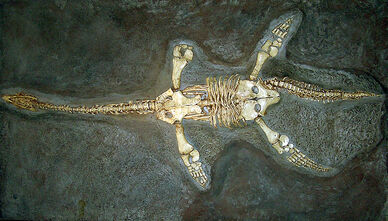
Cast of a Thalassiodracon hawkinsi skeleton (known as Hawkin's Plesiosaur) at Bristol City Museum, Bristol, England. Found in the Lower Lias strata, Street, in the county of Somerset, England. The original is in the Natural History Museum, London, England.
- You may be looking for Plesiosauria.
Plesiosaurs were carnivorous aquatic (mostly marine) reptiles. The common name 'plesiosaur' is applied both to the 'true' plesiosaurs (Suborder Plesiosauroidea) which includes both long-necked (elasmosaurs) and short-necked (polycotylid) forms and to the larger taxonomic rank of Plesiosauria, which includes the pliosaurs. The pliosaurs were the short-necked, large-headed plesiosaurians that were the apex predators for much of the Mesozoic. There were many species of plesiosaurs, while most of them were not as large as Elasmosaurus.
Plesiosaurs (sensu Plesiosauroidea) appeared at the start of the Jurassic Period and thrived until the K-T extinction, at the end of the Cretaceous Period. While they were Mesozoic reptiles that lived at the same time as dinosaurs, they were not dinosaurs.
History of Discovery[]
The first plesiosaur skeletons were found in England by Mary Anning, in the early 1800s, and were amongst the first fossil vertebrates to be described by science. Many have been found, some of them virtually complete, and new discoveries are made frequently. One of the finest specimens was found in 2002 on the coast of Somerset (England) by someone fishing from the shore. This specimen, called the Collard specimen after its finder, was on display in Taunton museum in 2007. Another, less complete skeleton was also found in 2002, in the cliffs at Filey, Yorkshire, England, by an amateur palaeontologist. The preserved skeleton is displayed at Scarborough Rotunda Museum.
Many museums have plesiosaur specimens. Notable among them is the collection of plesiosaurs in the Natural History Museum, London, which are on display in the marine reptiles gallery. Several historically important specimens can be found there, including the partial skeleton from Nottinghamshire reported by Stukely in 1719 which is the earliest written record of any marine reptile. Others specimens include those purchased from Thomas Hawkins in the early 19th century.
Specimens are on display in museums in the UK, including New Walk Museum, Leicester, The Yorkshire Museum, The Sedgwick Museum in Cambridge, Manchester Museum, Warwick Museum, Bristol Museum and the Dorset Museum. A specimen was put on display in Lincoln Museum (now The Collection) in 2005. Peterborough Museum holds an excellent collection of plesiosaur material from the Oxford Clay brick pits in the area. The most complete known specimen of the long-necked plesiosaur Cryptoclidus, excavated in the 1980s can be seen there.
Description[]
Plesiosaurs had a broad body and a short tail. They retained their ancestral two pairs of limbs, which evolved into large flippers. Plesiosaurs evolved from earlier, similar forms such as pistosaurs or very early, longer-necked pliosaurs. There are a number of families of plesiosaurs, which retain the same general appearance and are distinguished by various specific details. These include the Plesiosauridae, unspecialised types which are limited to the Early Jurassic period; Cryptoclididae, (e.g. Cryptoclidus), with a medium-long neck and somewhat stocky build; Elasmosauridae, with very long, inflexible necks and tiny heads; and the Cimoliasauridae, a poorly known group of small Cretaceous forms. According to traditional classifications, all plesiosaurs have a small head and long neck but, in recent classifications, one short-necked and large-headed Cretaceous group, the Polycotylidae, are included under the Plesiosauroidea, rather than under the traditional Pliosauroidea. Size of different plesiosaurs varied significantly, with an estimated length of Trinacromerum being 3 meters and Mauisaurus growing to 20 meters.
Taxonomy[]
The classification of plesiosaurs has varied; the following represents one version (see O'Keefe 2001)
- Superorder SAUROPTERYGIA
- Order PLESIOSAURIA
- Suborder Pliosauroidea
- Suborder Plesiosauroidea(Gray, 1825) Welles, 1943 sensu O'Keefe, 2001
- Plesiopterys O'Keefe, 2004
- Family Plesiosauridae Gray, 1825 sensu O'Keefe, 2001
- Attenborosaurus Bakker, 1993
- Plesiosaurus De la Beche & Conybeare, 1821
- (Unranked) Euplesiosauria O'Keefe, 2001
- ? Sthenarosaurus Watson, 1911 (nomen dubium)
- ? Eretmosaurus Seeley, 1874
- ? Leurospondylus Brown, 1913
- ? Nichollsia Druckenmiller & Russell, 2008
- Superfamily Cryptoclidoidea Williston, 1925 sensu O'Keefe, 2001
- Family Cryptoclididae Williston, 1925 sensu O'Keefe, 2001
- ? Tatenectes O’Keefe & Wahl, 2003
- ? Colymbosaurus Seeley, 1874
- Cryptocleidus Seeley, 1892
- Muraenosaurus Seeley, 1874
- Pantosaurus Marsh, 1891
- Vinialesaurus Gasparini, Bardet & Iturralde-Vinent, 2002
- (Unranked) Tricleidia O'Keefe, 2001
- Family Tricledidae Nova
- Tricleidus Andrews, 1909
- Family Cimoliasauridae Delair, 1959 sensu O'Keefe, 2001
- ? Aristonectes Cabrea, 1941
- Kaiwhekea Cruickshank & Fordyce, 2002
- Kimmerosaurus Brown, 1981
- Cimoliasaurus Leidy, 1851 (nomen dubium)
- Family Polycotylidae Williston, 1909 sensu O'Keefe, 2001
- Dolichorhynchops Willison, 1903
- ? Edgarosaurus Druckenmiller, 2002
- ? Georgiasaurus Otschev, 1978
- Manemergus Buchy, Metayer, & Frey, 2005
- Polycotylus Cope, 1869
- Sulcusuchus Gasparini & Spalletti, 1990
- Thililua Bardet, Pereda Suberbiola & Jalil, 2003
- Trinacromerum Cragin, 1888
- Family Elasmosauridae Cope, 1869 sensu Bardet, Godefroit & Sciau, 1999
- Microcleidus Watson, 1911
- ? Morenosaurus Welles, 1943
- Occitanosaurus Bardet, Godefroit & Sciau, 1999
- Family Elasmosauridae Cope, 1869 sensu O'Keefe, 2001
- ? Aphrosaurus Welles, 1943
- Brancasaurus Wegner, 1914
- Callawayasaurus Carpenter, 1999
- Elasmosaurus Cope, 1869
- ? Fresnosaurus Welles, 1943
- ? Futabasaurus Sato, Hasegawa & Manabe, 2006
- ? Goniosaurus Meyer, 1860
- ? Hydrotherosaurus Welles, 1943
- ? Hydralmosaurus Welles, 1943
- Libonectes Carpenter, 1997
- ? Mauisaurus Hector, 1874
- ? Ogmodirus Williston & Moodie, 1913 (nomen dubium)
- ? Orophosaurus Cope, 1887 (nomen dubium)
- ? Piptomerus Cope, 1887 (nomen vanum)
- Styxosaurus Welles, 1943
- ? Terminonatator Sato, 2003
- ? Thalassomedon Welles, 1943
- ? Tuarangisaurus Wiffen & Moisley, 1986
- ? Woolungasaurus Persson, 1960
- Family Tricledidae Nova
- Family Cryptoclididae Williston, 1925 sensu O'Keefe, 2001
- Order PLESIOSAURIA